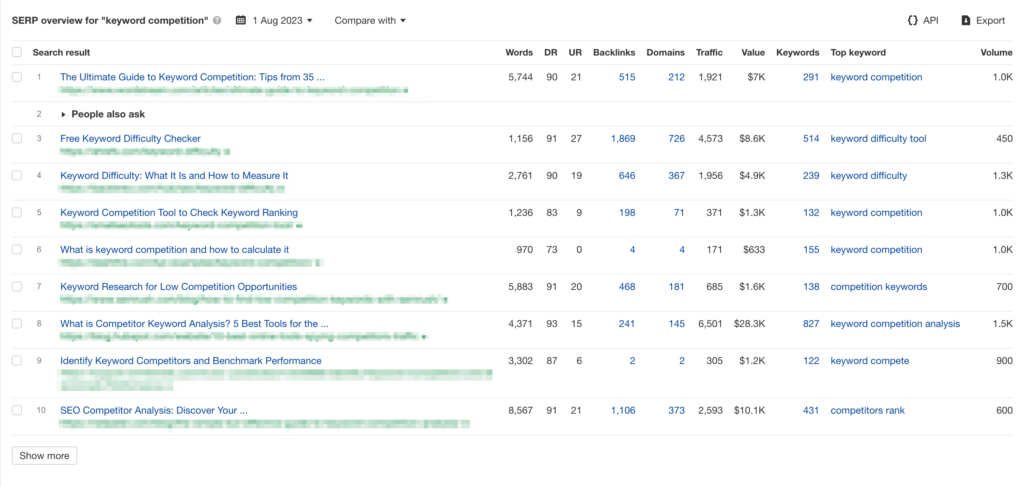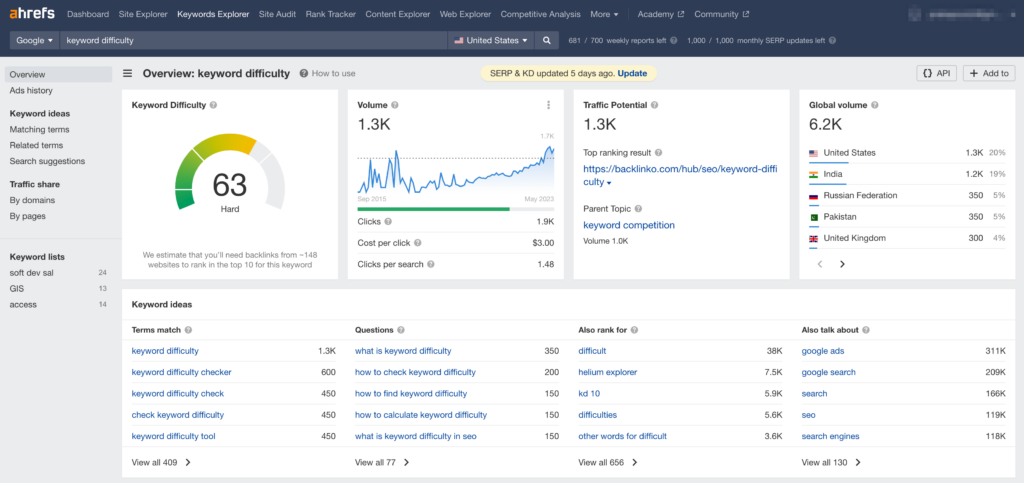
When it comes to search engine optimization (SEO), keyword research plays a crucial role in improving your website’s visibility and driving organic traffic. However, not all keywords are created equal. Some are more competitive than others, and understanding Keyword Difficulty and Competition is essential for an effective SEO strategy.
In this article, we will explore what Keyword Difficulty is, why it’s important, factors that impact Keyword Difficulty, how to check Keyword Difficulty using various tools, and how it relates to Keyword Competition.
What is Keyword Difficulty in SEO?
In SEO, Keyword Difficulty (KD) plays a significant role. But what exactly is Keyword Difficulty? In simple terms, Keyword Difficulty refers to the level of competition associated with a particular keyword. It provides an understanding of how challenging it would be to rank for a specific keyword on search engine result pages (SERPs).
When you perform keyword research, you encounter various keywords that are relevant to your website or business. Some keywords are highly competitive, meaning many other websites are vying for the top positions in search results. On the other hand, some keywords have lower competition, making it relatively easier to rank for them.
SEO Keyword Difficulty is typically measured using a score that indicates the level of competition for a particular keyword. This score helps SEO professionals and website owners determine the amount of effort and resources required to achieve a higher ranking for that keyword. By assessing Keyword Difficulty, you can make informed decisions about which keywords to target in your SEO strategy.
For example, a keyword like “digital marketing agency” is likely to have high competition, as many agencies are competing to rank for it. On the other hand, a long-tail keyword like “affordable digital marketing agency in New York” may have lower competition, as it is more specific and targets a narrower audience.
Why Is Keyword Difficulty Important?
Imagine you own a website offering professional photography services. Your aim is to rank high on search engine result pages (SERPs) for keywords like “wedding photographer” or “portrait photography.” However, you soon realize that these keywords are highly competitive, making it difficult to secure a prominent position. This is where keyword difficulty analysis becomes invaluable.
Understanding keyword difficulty is crucial for several reasons. First, it allows you to prioritize your SEO efforts by focusing on keywords that offer a balance between search volume and competition. Targeting highly competitive keywords without considering their difficulty level may result in a considerable investment of time and resources with little return. On the other hand, solely targeting low-competition keywords may limit your potential reach and impact.
By analyzing keyword difficulty, you can identify keywords that have a reasonable level of competition, offering a higher probability of ranking well in search results. This strategic approach maximizes your chances of attracting organic traffic to your website and achieving your SEO goals.
Which Factors Impact on Keyword Difficulty Score?
Keyword Difficulty is influenced by various factors that shape the competitive landscape for specific keywords:
Domain authority (DA)
Domain authority is a metric that indicates the overall authority and credibility of a website. Websites with higher domain authority tend to have an advantage when it comes to ranking for competitive keywords. Search engines consider websites with established authority as more trustworthy and relevant. Therefore, keywords associated with industries or niches dominated by high-authority websites may have higher Keyword Difficulty scores.
Backlink quality
The quality and quantity of backlinks pointing to a website or webpage significantly impact Keyword Difficulty. Backlinks from authoritative and relevant sources are considered valuable by search engines. Websites with a strong backlink profile, comprising high-quality and relevant backlinks, often have an advantage in ranking for competitive keywords. Building a robust backlink profile can positively influence your ability to compete for keywords with higher difficulty.
Content quality
Google’s search approach places a strong emphasis on providing users with high-quality and relevant content. Search engines evaluate the relevance and quality of the content associated with a particular keyword. Creating well-optimized, informative, and engaging content that aligns with user intent is crucial because high-quality content has a better chance of ranking well, even for moderately competitive keywords.
Search intent
Understanding the intent behind a user’s search query is essential in Keyword Difficulty analysis. Different keywords have different search intents, such as informational, navigational, or transactional. Analyzing the types of pages that appear in the top 10 search results for a keyword can provide insights into the search intent. Aligning your content with the user’s search intent increases the relevance in SEO of your website and boosts your chances of ranking well for that keyword.
Competitors
The competitor analysis plays a significant role in determining Keyword Difficulty. Analyzing your competitors’ strategies and the strength of their SEO is vital. Identify your main competitors for specific keywords and assess their website authority, backlink profiles, and content quality. Understanding the strengths and weaknesses of your competitors can help you develop a targeted SEO strategy to overcome the competition.

How to Check Keyword Difficulty?
Checking Keyword Difficulty is an essential step in keyword research and SEO strategy development. Several tools provide a “Keyword Difficulty score” that indicates the level of competition for a specific keyword. Here are some popular tools and their features for checking Keyword Difficulty:
Ahrefs
Ahrefs offers a comprehensive keyword analysis tool that provides a Keyword Difficulty score. This score ranges from 0 to 100, with higher scores indicating higher competition. Ahrefs calculates the KD based on the number and quality of backlinks to the top-ranking pages for a keyword, as well as the Domain Rating of those pages. Additionally, Ahrefs provides valuable insights into backlink profiles, organic search traffic, and SERP features for a more comprehensive analysis.
Semrush
Semrush also offers a Keyword Difficulty score to assess competition levels. The score ranges from 0 to 100, with higher scores indicating higher difficulty. Semrush calculates the KD by considering factors such as domain authority, URL authority, and the number of referring domains to the top-ranking pages for a keyword. Semrush provides additional features like competitor analysis, organic search insights, and content optimization recommendations.
Moz
Moz’s Keyword Explorer provides a Keyword Difficulty metric on a scale of 0 to 100. It estimates how hard it is to rank for a keyword by considering multiple factors, including page authority, domain authority, and the competitiveness of the search results. Moz’s tool also offers insights into search volume, organic CTR (click-through rate), and keyword opportunities.
Serpstat
Serpstat offers a similar Keyword Difficulty metric ranging from 0 to 100. Their calculation considers the domain’s visibility index, the number of referring domains, and the URL’s visibility index for the top-ranking pages. Serpstat also provides detailed SEO analytics, competitor analysis, and keyword research features.
While these tools provide valuable insights, it’s recommended to manually re-check the competition of keywords. Analyze the top 10 search engine results pages (SERPs) within the same tools and assess the types of pages ranking for the keyword. Look for websites with high domain authority, a significant number of backlinks, and content relevant to the search intent. Even if a keyword has a low KD, competing against high-authority pages can still be challenging.
Additionally, analyze the intent of the search query and the types of pages ranking in the search results. If the top results predominantly consist of blog articles, it might be difficult to compete with a service page. In such cases, consider choosing a keyword with commercial intent or creating a separate blog page to target that specific keyword.
By combining the insights from Keyword Difficulty tools and manual analysis of the SERPs, you can make more informed decisions and develop a well-rounded keyword strategy that maximizes your chances of ranking well and driving organic traffic. And a professional SEO company can help you with that.
What is a Good Keyword Difficulty?
Determining a good Keyword Difficulty level is essential for prioritizing your keyword targeting and optimizing your SEO. Now we explain the main parameters for low, medium, and high-difficulty keywords and discuss when it is better to use each category.
Low-Difficulty Keywords (Range: 0-20)
These keywords have low competition and are relatively easier to rank for. They often have fewer authoritative websites targeting them, lower domain authority of ranking pages, and fewer backlinks required to compete.
Targeting low-difficulty keywords can be advantageous for new websites, businesses with limited resources, or those aiming for quick wins. They offer opportunities to establish an online presence, gain visibility, and attract targeted organic traffic. Additionally, ranking for multiple low-difficulty keywords can build the foundation for gradually targeting more competitive keywords.
Medium-Difficulty Keywords (Range: 21-70)
Medium-difficulty keywords have moderate competition and require a balanced approach to compete effectively. They may have a mix of authoritative and niche websites targeting them, moderate domain authority of ranking pages, and a moderate number of backlinks required to rank well.
Targeting medium-difficulty keywords allows you to strike a balance between competition and potential traffic. These keywords often have a significant search volume and can attract a substantial amount of organic traffic if optimized well. They are suitable for established websites looking to expand their reach, target specific audience segments, and establish authority within their niche.
High-Difficulty Keywords (Range: 71-100)
High-difficulty keywords have intense competition and require significant resources, effort, and time to rank well. They are often targeted by authoritative websites with high domain authority, a substantial number of backlinks, and well-optimized content.
While high-difficulty keywords present challenges, successfully ranking for them can yield substantial benefits. These keywords typically have high search volume, indicating significant user interest and potential traffic. Targeting high-difficulty keywords is beneficial for established websites with strong authority, extensive resources, and a well-developed SEO strategy. It allows you to compete in competitive markets, dominate search engine results, and establish your brand as an industry leader.
When determining the ideal Keyword Difficulty level for your SEO, consider factors such as your website’s domain authority or domain rating, resources, competition analysis, and long-term goals. A balanced approach is often recommended, targeting a mix of low, medium, and high-difficulty keywords to diversify your keyword portfolio and capture a broad range of organic traffic.
Keyword Difficulty vs Keyword Competition
In the realm of SEO, two important concepts often come into play: Keyword Difficulty (KD) and Keyword Competition (KC). While they are related, it’s essential to understand the distinction between them.
Keyword Difficulty assesses the level of challenge you’ll encounter in ranking for a specific keyword. It takes into account factors like domain authority, backlink quality, content quality, and search intent. A higher Keyword Difficulty score indicates more competition and a greater effort required to rank well.
Keyword Competition, on the other hand, focuses on the number and strength of competitors targeting the same keyword. It involves analyzing the competing websites, their backlink profiles, and their content strategies. Understanding KC helps you gauge the existing competition for a particular keyword.
Keyword Difficulty and Keyword Competition are interconnected but distinct metrics. KD informs you about the level of effort required to rank for a keyword, considering various factors. On the other hand, KC helps you understand the competitive landscape and the strength of other websites targeting the same keyword.
Also, Keyword Competition is often referred to how many advertisers are bidding on a particular keyword in paid search. It takes into account factors such as the number of advertisers bidding on that keyword, the quality of their ads, and their ad spend. Therefore, KC is also often associated with the Pay-Per-Click (PPC) marketing parameter.
While both concepts are important, they are not the same thing. Understanding the difference between them can help you create a more effective SEO strategy.
By examining both KD and KC, you gain a comprehensive understanding of the challenges and opportunities associated with your focus keywords. This knowledge allows you to make informed decisions about keyword selection, content optimization, and competitive strategies.

How to Check Keyword Competition?
Checking Keyword Competition is an essential step in optimizing your SEO strategy. Understanding the level of competition for specific keywords allows you to assess the challenges you may face and devise effective tactics to rank higher in search engine results. Here are some practical methods to check Keyword Competition:
- • Google Keyword Planner: The Google Keyword Planner, available through the Google Ads platform, is a useful tool to assess Keyword Competition. Enter your target keywords or phrases, and the tool will provide insights into their search volume and competition level. The competition metric indicates the level of competition among advertisers, but keep in mind that it doesn’t directly reflect organic competition.
- • Manual Search Engine Analysis: Conduct a manual search on search engines like Google using your target keywords. Analyze the top search results and observe the websites that rank highly. By using the appropriate tools, look for parameters such as Domain Authority, backlink profiles, and content relevance. If the top-ranking pages belong to high-authority websites with extensive backlinks, it indicates high competition.
- • Competitor Analysis: Identify your main competitors in your niche and analyze their SEO strategies. Tools like Ahrefs, SEMrush, or Moz can provide valuable insights into competitors’ domain authority, backlinks, and organic traffic. By understanding their strengths and weaknesses, you can gain a better understanding of the competition you’ll be up against.
- • Content Relevance and Search Intent: Assess the types of content that appear in the top search results for your target keywords. Determine whether they align with the search intent and relevance. If the top-ranking pages are predominantly blog articles, it may indicate an opportunity to create informative and engaging content to compete effectively.
- • Social Media and Online Communities: Explore social media platforms, online forums, and communities related to your industry. Observe discussions, topics, and trends related to your target keywords. This can provide valuable insights into the level of interest and competition surrounding those keywords.
Please note that Keyword Competition can vary across industries, niches, and geographical locations. It’s crucial to consider multiple factors, including domain authority, backlink profiles, and content quality, in conjunction with the insights provided by keyword research tools. By combining various methods and thoroughly analyzing the competition, you can make informed decisions about the keywords to target and devise effective SEO strategies.
Low competition vs High competition keywords: How to use them?
When it comes to keyword selection, you’ll encounter both low competition and high competition keywords. Each category presents unique opportunities and considerations for your SEO strategy. It is extremely important to find the right balance between the two.
To make the most of low and high competition keywords, consider the following approaches:
- 1. Balanced Keyword Portfolio: Maintain a balanced keyword portfolio by targeting a mix of low, medium, and high competition keywords. This diversifies your SEO strategy, allowing you to capture different segments of organic traffic and reduce reliance on a single keyword category.
- 2. Gradual Expansion: Start by targeting low competition keywords to gain momentum and establish a solid foundation. As your website grows in authority, gradually incorporate high competition keywords into your strategy.
- 3. Long-Tail Keywords: Emphasize long-tail keywords within low competition segments. These highly specific and targeted keywords attract users with clear intent, increasing the chances of conversion. Focus on addressing niche topics and providing valuable content to these users.
- 4. Content Depth and Quality: For high competition keywords, invest in creating high-quality, comprehensive, and engaging content. Conduct thorough research, offer unique insights, and provide exceptional value to stand out from the competition.
- 5. Link Building and Outreach: In competitive spaces, prioritize building high-quality backlinks from authoritative websites. Develop relationships with influencers, guest post on relevant blogs, and engage in outreach activities to enhance your website’s authority and increase its chances of ranking for high competition keywords.
- 6. Adapt and Evolve: Regularly monitor keyword performance and adapt your strategy based on data insights. Analyze the success and challenges of your low and high competition keyword targeting, making necessary adjustments to optimize your SEO continually.
By strategically incorporating both low and high competition keywords into your SEO strategy, you can maximize your organic visibility, attract targeted traffic, and establish your website as an authoritative presence within your industry.
Keyword Difficulty & Keyword Competition: Final Thoughts
As we conclude our exploration of Keyword Difficulty and Keyword Competition, it is clear that these factors play a pivotal role in shaping your SEO strategy. Analyzing Keyword Difficulty and Competition empowers you to make informed decisions, target the right keywords, and optimize your content for better search engine rankings.
At Mellow Promo, we offer comprehensive content marketing services that can help you navigate the complexities of Keyword Difficulty and Competition. We continuously monitor your keyword performance, analyze data insights, and optimize your content strategy accordingly. This iterative approach ensures that your SEO efforts remain effective and adaptable.
By partnering with Mellow Promo, you gain access to a team of dedicated professionals who are well-versed in Keyword Difficulty, keyword competition analysis, and content marketing. We combine our expertise with industry-leading tools and techniques to drive organic traffic, enhance your online presence, and help you achieve your business objectives.
Take the next step in optimizing your SEO strategy by leveraging our content marketing services at Mellow Promo. Contact us to explore how we can assist you in conquering Keyword Difficulty and outshining your competition.
FAQs
How to calculate Keyword Difficulty?
Keyword Difficulty is calculated by analyzing various factors such as domain authority, backlink quality, and content relevance to determine how challenging it is to rank for a specific keyword.
What does the Keyword Difficulty score tell you?
The Keyword Difficulty score provides an estimate of how difficult it will be to rank for a keyword. It helps you gauge the level of competition and assess the effort required to achieve a higher ranking.
How to check Keyword Competition on Google?
You can check Keyword Competition on Google by examining the search engine results pages (SERPs) and analyzing the types of pages and the number of backlinks of the top-ranking websites for your target keyword.
What is a low competition keyword?
A low competition keyword refers to a keyword that has relatively less competition, making it easier to achieve higher rankings in search engine results. These keywords often have lower search volume but can be highly targeted.
Are the Keyword Difficulty and Keyword Competition similar metrics?
While related, Keyword Difficulty and Keyword Competition are not the same metrics. Keyword Difficulty focuses on the level of effort required to rank for a keyword, whereas Keyword Competition examines the number and strength of competitors targeting the same keyword.





